In order to participate in the GunBroker Member forums, you must be logged in with your GunBroker.com account. Click the sign-in button at the top right of the forums page to get connected.
6.5x55 Ackley load ladder w/RL22 (PICS)
Alright gents, I will post this both for the folks who would care, and those who are maybe looking to gain some understanding of the lingo and techniques used to determine the "sweet spot" for a particular barrel/rifle/load combo. Earlier in another post nononsense mentioned that posting these pics would help greatly, those who are entering into the handloading game. I wish I had them back when I THOUGHTI had an grasp of the accuracy game and loading for it. This is IMHO the fastest and most accurate way to find your rifle's preference for any chosen combination of bullet and powder.
The Ladder method was developed by Creighton Audette (do a search, this ain't the friggin library[:0][;)]) the theory states that by loading 1 load at a time with your chosen powder and bullet, and increasing by .2gr increments in small cases, and .3gr increments in large cases, you can shoot a "ladder" of increasing charges which will yield clusters of several bullets within a charge range, as the shots "walk up" the paper. This is done by firing ONE bullet of each charge range, then on the the next highest range, and so on. IMHO, to do it this way, at least 300yds needs to be used to get the dispersion between the bullets to be interpretable with the acceptance of human error.
Now, there is also another theory that I incorporate called "Optimal Charge Weight" theory. This is Dan Newberry's version (still not the library). What he sais is that by loading your ladder in multiple sets and fired "round robin" style, you can more effectively spread the human error across the data set. What you do in this test, instead of using 1 target with 1 aimpoint and firing your ladder, you use a target for each charge wieght. Now, you fire each new charge weight at a different target with the same POA. Then, you repeat the ladder up to say 4-5 times using that same process so that 4-5 rnds of the same charge have been fired at their respective targets. However, by firing them in the ladder order instead of the 5 shot string of same charge weight method, you will more evenly disperse the human error acorss the groups. You will see a far better set of data using this alteration of the Creighton Audette method as it was origninaly.
Now, as to harmonics, your barrel will vibrate in it's own frequency. Every barrel is different, but many in similar lengths, chamberings, twists, etc will fall into very similar harmonic frequency. A barrel's vibrational rotation as a bullet passes throught the bore and exits the muzzle, will resmeble the shape of the "infinity" symbol. The goal is to load your rounds so that they will exit the muzzle as the barrel is passing the center point of that cycle where it is the most uniform and stable. At this point, your loads will be the best match for your barrel and chambering and will be REPEATABLY accurate.
So here is the load ladder results, fired round robin, for RL22 in fireformed Lapua brass, match prepped, with FGGM 210 primers, and the impressive 140gr A-MAX pill from a PacNor 1:8 Twist 26" select match SS 4 groove tube that is a staright taper form 1.125"-.920", chambered for the 6.5x55 Ackely Improved caliber on a blueprinter WIN70 action with a jewell trigger, HS Precision Stealth stock, Badger ordnance tactical 20MOA base and tactical rings (lapped) and a Nightforce NXS 8-32x56mm Scope with the R2 reticle. The ladder was fired at 200yds. The first ladder can very easily be seen to be higher as the first 5 rounds I used to foul the bore in on the clean barrel were obviously not enough to settle her in. The next 4 ladders POI will prove to be consistent with a properly fouled bore.
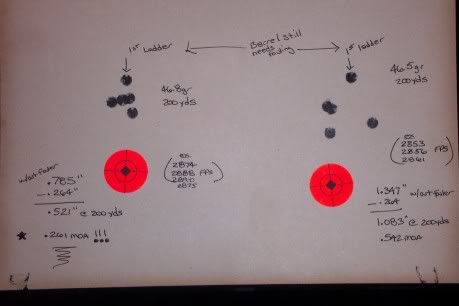
notice the first group of 46.5gr shows not much promise, but has begun to create a more circular pattern, indicative of an approaching sweet spot (nearing the middle of the infinty shaper cycle) Also notice the high POI for the first ladder while fouling the bore.
Now, see how the 46.8gr load is tighter and more centered. This group at 200yds shows a sweet spot has been touched upon.
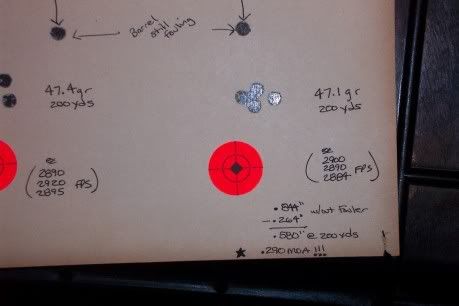
Now, take notice that this 47.1gr load is STILL in the sweet spot (only .3gr increase) and has really tightened up.
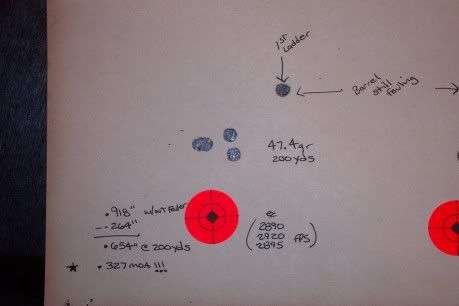
47.4gr is at the end of the sweet cycle. with maybe a hint of horizontle dispersion appearing now.

AND, as if majic were afoot, the group spreads back out horizonatly and verticaly after only another .3gr increase. This shows that the bullet is exiting the muzzle at variuos points in the cycle shaped like the "infinity" symbol. Picture the bore rotating in that motion, and the bullet exiting at variuos points, and you can see how these groups appear like this, it is NOT coincidence.
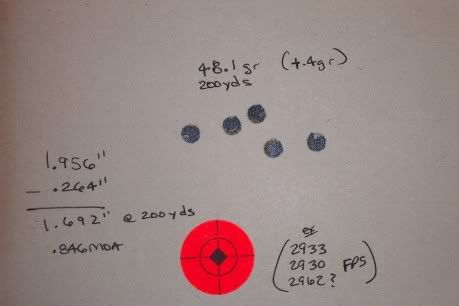
Now the next .4gr increase (in a hurry), the group is slightly less in size, but still resembles the last group.
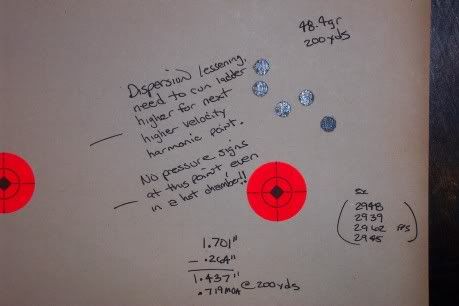
And finally we end up at the 48.4gr load which as you can see has started to "walk" back together showing the bullets are now entering a zone where they exit the bore closer to center of the vibration and are starting to "centralize" themselves. Had I run the ladder up another few charges, the groups would have come back together to resemble the first set that were in the "sweet spot".
These two charge ranges will be referred to as the "lower harmonic" and the "higher harmonic" point respectively.
Hope this provides some help for new loaders and yields some data for those who may be interested in the caliber or bullet used.
why chase the game when the bullet can get em from here?....
Got Balistics?
The Ladder method was developed by Creighton Audette (do a search, this ain't the friggin library[:0][;)]) the theory states that by loading 1 load at a time with your chosen powder and bullet, and increasing by .2gr increments in small cases, and .3gr increments in large cases, you can shoot a "ladder" of increasing charges which will yield clusters of several bullets within a charge range, as the shots "walk up" the paper. This is done by firing ONE bullet of each charge range, then on the the next highest range, and so on. IMHO, to do it this way, at least 300yds needs to be used to get the dispersion between the bullets to be interpretable with the acceptance of human error.
Now, there is also another theory that I incorporate called "Optimal Charge Weight" theory. This is Dan Newberry's version (still not the library). What he sais is that by loading your ladder in multiple sets and fired "round robin" style, you can more effectively spread the human error across the data set. What you do in this test, instead of using 1 target with 1 aimpoint and firing your ladder, you use a target for each charge wieght. Now, you fire each new charge weight at a different target with the same POA. Then, you repeat the ladder up to say 4-5 times using that same process so that 4-5 rnds of the same charge have been fired at their respective targets. However, by firing them in the ladder order instead of the 5 shot string of same charge weight method, you will more evenly disperse the human error acorss the groups. You will see a far better set of data using this alteration of the Creighton Audette method as it was origninaly.
Now, as to harmonics, your barrel will vibrate in it's own frequency. Every barrel is different, but many in similar lengths, chamberings, twists, etc will fall into very similar harmonic frequency. A barrel's vibrational rotation as a bullet passes throught the bore and exits the muzzle, will resmeble the shape of the "infinity" symbol. The goal is to load your rounds so that they will exit the muzzle as the barrel is passing the center point of that cycle where it is the most uniform and stable. At this point, your loads will be the best match for your barrel and chambering and will be REPEATABLY accurate.
So here is the load ladder results, fired round robin, for RL22 in fireformed Lapua brass, match prepped, with FGGM 210 primers, and the impressive 140gr A-MAX pill from a PacNor 1:8 Twist 26" select match SS 4 groove tube that is a staright taper form 1.125"-.920", chambered for the 6.5x55 Ackely Improved caliber on a blueprinter WIN70 action with a jewell trigger, HS Precision Stealth stock, Badger ordnance tactical 20MOA base and tactical rings (lapped) and a Nightforce NXS 8-32x56mm Scope with the R2 reticle. The ladder was fired at 200yds. The first ladder can very easily be seen to be higher as the first 5 rounds I used to foul the bore in on the clean barrel were obviously not enough to settle her in. The next 4 ladders POI will prove to be consistent with a properly fouled bore.

notice the first group of 46.5gr shows not much promise, but has begun to create a more circular pattern, indicative of an approaching sweet spot (nearing the middle of the infinty shaper cycle) Also notice the high POI for the first ladder while fouling the bore.
Now, see how the 46.8gr load is tighter and more centered. This group at 200yds shows a sweet spot has been touched upon.

Now, take notice that this 47.1gr load is STILL in the sweet spot (only .3gr increase) and has really tightened up.

47.4gr is at the end of the sweet cycle. with maybe a hint of horizontle dispersion appearing now.

AND, as if majic were afoot, the group spreads back out horizonatly and verticaly after only another .3gr increase. This shows that the bullet is exiting the muzzle at variuos points in the cycle shaped like the "infinity" symbol. Picture the bore rotating in that motion, and the bullet exiting at variuos points, and you can see how these groups appear like this, it is NOT coincidence.

Now the next .4gr increase (in a hurry), the group is slightly less in size, but still resembles the last group.

And finally we end up at the 48.4gr load which as you can see has started to "walk" back together showing the bullets are now entering a zone where they exit the bore closer to center of the vibration and are starting to "centralize" themselves. Had I run the ladder up another few charges, the groups would have come back together to resemble the first set that were in the "sweet spot".
These two charge ranges will be referred to as the "lower harmonic" and the "higher harmonic" point respectively.
Hope this provides some help for new loaders and yields some data for those who may be interested in the caliber or bullet used.
why chase the game when the bullet can get em from here?....
Got Balistics?


Comments
I will be running a 100 yard & 200 yard test. I am calling it the 10x10. 10 rounds of the same powder charge & bullet. Stepped the powder up .3 grain....Probably be a week or two.
That is interesting about barrel harmonics. Should look like a repeatable hour glass stacked on another hour glass all the way up the ladder.
why chase the game when the bullet can get em from here?....
Got Balistics?
Again thanks for the info.
yeah .2gr can creep up a ton of pressure in small cases like 222 and 223 etc. I find anything with a 308 style body and on up, will take .3gr increases and magnums can possible even be given .4gr increases depending on thier internal capacity.
dcloco, I think you will find it to resemble more of an hourglass layed down on it's side, or a sideways "8". It just seems to look the same on all 3 rifles and targets I have run in the past 3 weeks. It takes time letting the barrel cool to get accurate chrono results and POI results (don't want chamber heat raising pressures and MV's), but after 1 1/2hrs or so, you will have the load range narrowed down to 2 charge ranges for "low" and "high" harmonics, with very little barrel life lost and only 1 range session (or 2 if you didn't load high enough like I did, and have to go run some higher charges).
why chase the game when the bullet can get em from here?....
Got Balistics?